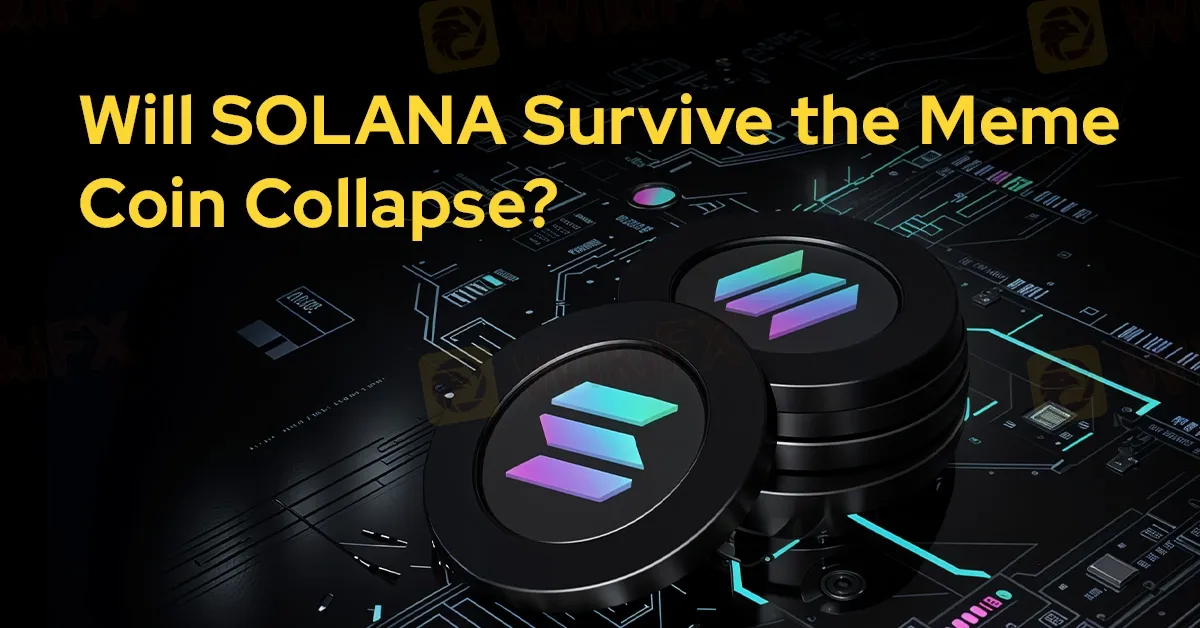简体中文
繁體中文
English
Pусский
日本語
ภาษาไทย
Tiếng Việt
Bahasa Indonesia
Español
हिन्दी
Filippiiniläinen
Français
Deutsch
Português
Türkçe
한국어
العربية
Will SOLANA Survive the Meme Coin Collapse?
Abstract:After reaching an all-time high of $261 in January, Solana (SOL) has seen its value decline, driven largely by the cooling of the meme coin frenzy that had fuelled its rapid ascent.

After reaching an all-time high of $261 in January, Solana (SOL) has seen its value decline, driven largely by the cooling of the meme coin frenzy that had fuelled its rapid ascent. Currently trading around the $168 level for the first time since November, concerns have emerged regarding the blockchain's dependence on speculative trading and whether it can maintain long-term momentum.
Solana‘s recent surge in popularity was primarily propelled by the speculative minting of meme coins, many of which lacked fundamental utility and were often linked to pump-and-dump schemes. These speculative assets attracted retail investors seeking quick gains, only to result in significant losses as the market corrected itself. As enthusiasm for these tokens diminishes, Solana’s price has followed suit, further impacted by broader weakness across the digital asset market.

Tokens such as MELANIA and LIBRA contributed to Solana‘s heightened volatility, exacerbating concerns over insider trading and market manipulation. The rapid price fluctuations triggered significant liquidations, further driving SOL’s decline. Critics have pointed out that the unregulated nature of these launches allowed early participants to offload their holdings onto retail investors at artificially inflated prices, accelerating the downturn.
Despite the challenges posed by its reliance on speculative trading, Solana continues to attract users due to its low transaction costs and high-speed processing capabilities. These features have made it a preferred network for high-frequency trading and retail speculation, contributing to robust on-chain activity. While its recent struggles highlight the risks of unchecked speculation, some analysts argue that such activity remains a fundamental aspect of the broader cryptocurrency market and is unlikely to disappear entirely.
Institutional interest in Solana remains strong despite recent setbacks. Investment firms such as VanEck and Bitwise have recently submitted proposals with the Chicago Board Options Exchange (CBOE) for Solana-based exchange-traded products (ETPs), underscoring confidence in the blockchains long-term potential.

Disclaimer:
The views in this article only represent the author's personal views, and do not constitute investment advice on this platform. This platform does not guarantee the accuracy, completeness and timeliness of the information in the article, and will not be liable for any loss caused by the use of or reliance on the information in the article.
Read more

10 Signs of a Fake Forex Trading or Crypto Website
Been to a forex trading or crypto website promising guaranteed returns, displaying too good to be true testimonials and far too many impressive features? Beware, it's a SCAM! In this article, we discuss 10 signs of a fake forex trading or cryptocurrency website.

Breaking News: OmegaPro Caught in a $650 Million Forex and Crypto Investment Scam
An indictment was leveled against two men in the District of Puerto Rico for their alleged involvement in the operation and promotion of OmegaPro, an international investment scheme that has led to financial losses worth over $650 million for investors. Check more about this story

BaFin Issues Warnings Against Unauthorised Crypto and Investment Platforms
BaFin has recently flagged multiple websites, including stcwelt.com and mega-platz.pro, for offering financial and cryptoasset services without proper authorisation. Stay informed and protect your investments.

CryptoCurrency Regulations in India 2025 – Key Things You Should Know
Cryptocurrency has become a major trend in today’s world. Crypto Experts believe it’s the future, which is why many people are investing heavily in it. But before jumping in, it’s important for crypto enthusiasts to understand the key rules about cryptocurrency in India.
WikiFX Broker
Latest News
Exness Halts New India Accounts Amid Regulatory Change
eToro and BridgeWise Launch AI Smart Portfolio for US Mid-Cap Stocks
Contemplating Investments in Quotex? Abandon Your Plan Before You Lose All Your Funds
How family offices can protect the bottom line when putting family members on payroll
Meta says it won't sign Europe AI agreement, calling it an overreach that will stunt growth
Ether and trading stocks take the crypto spotlight as Congress passes historic stablecoin bill
Inflation outlook tumbles to pre-tariff levels in latest University of Michigan survey
Peter Thiel-backed cryptocurrency exchange Bullish files to go public on NYSE
What a Trump, Powell faceoff means for your money
Ether takes crypto spotlight as Congress passes historic stablecoin bill
Currency Calculator


